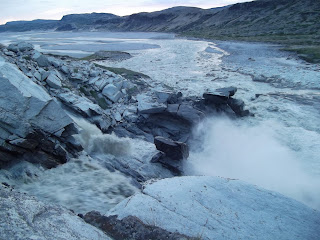This year’s cold spring and late start to the summer has delayed the melt season by a month compared to last year’s record-breaking melt season. In 2010, rivers discharging the glaciers of West Greenland were higher than in anyone’s memory and the glaciers themselves accelerated towards the ocean. Multiple outburst events happened at our field site at Leverett Glacier when hundreds of lakes on top of the Greenland Ice Sheet drained through cracks in the ice. This sent surge after surge of meltwater to the base of the ice sheet and to the river the team was sampling.
 |
| The river the day before the outburst event with 2 meters of ice still covering it. |
Recently, scientists have hypothesized that these drainage events alter the subsurface hydrology of the Greenland Ice Sheet. Inefficient, small meltwater channels are widened and straightened by the sudden influx of water when lakes drain. This process is thought to create highly efficient pathways for meltwater to reach the front of glaciers and acts to lubricate and melt the ice sheet’s base.
This year, we’ve had only one major drainage event. This happened at the beginning of June when it appears that every supraglacial lake between the ice sheet margin and 24 miles up the ice sheet drained at once. We think what happened was one large lake drained and sent cracks in many directions, draining other lakes, making more cracks, and so on. When this happened, our sensors indicated the river rose over six feet in thirteen hours and another two feet the following day. This shattered the river’s five-foot-thick ice in an afternoon. In a day, the river changed from a highway of ice to a raging torrent of class IV rapids full of icebergs. There were seven-foot-tall wave trains, deep holes, and icebergs and boulders slamming through the 32ºF water. The day before we had walked up river ice to the glacier’s portal.
For about a week the river ran wild. It became turbid and opaque, obscuring massive boulders we could hear thundering downriver. The riverbank disintegrated rapidly and became a high steep slope of loose boulders and dust. Falling in could have been deadly so we set up a harness and climbing rope to collect samples. As our luck would have it, the day before two people were flown out of camp to the ice sheet, one person was sent into town to fix an instrument, and two potential team members were unable to make their flights to Greenland. So for several days there were only two people in camp and later that week, only three or four.
 |
| Louise not letting a little stream stop her from hiking on the moraines. |
For three nights in a row, I sampled the river every hour all night for our gas tracing experiments. I spent my days moving equipment up the eroding bank, taking samples for my research, and helping make discharge measurements. Sleep happened in short bursts and exhaustion took hold. I’m proud to say that through the entire outburst event, our probes remained in the water and our computerized data loggers stayed dry. We succeeded in capturing the chemical nature of the massive supraglacial lake drainage event from its start to its finish in the middle of a gas tracer experiment.
But after a week of running ourselves into the ground, our luck ran out. The rising river and icebergs were relentlessly ripping the riverbank down. Eventually the tubing for my radon detector and probe were only just long enough to reach the river while the detector was perched on the bank’s edge. In my sleep-deprived state, I didn’t think to try to lengthen the tubing and as we were checking (and moving, when necessary) the equipment many times a day, this seemed like the best we could do. Knowing the bank was unstable, we drilled rock bolts into a cliff and tied everything to these bolts but even this was not enough. One morning, after checking the equipment at the river, a few people and myself decided to hike over the glacier to sample at the portal. While we were gone, a large section of riverbank slid into the rapids, taking my radon detector with it. When we got back from our hike, all the probes were dangling from their rock bolts bouncing against the cliff in a set of new rapids where the bank had been only hours before. With a bit of rock climbing over the water, we managed to salvage everything except my lost detector. We pulled everything out and set it all up again 500 yards downstream on a large rock outcrop where it still is today.
When you’ve been completely defeated after a long battle, there is pretty much nothing left to do but laugh. The night after I lost the detector, I sat in the mess tent with the rest of the team feeling completely lost. Then over the course of dinner and the night’s conversation, we started joking about the week’s stress, making light of everything, and laughing hard to release the pressure. The following week, I scavenged together enough tubing from around camp to set up another radon detector that is still currently deployed.
Today we are still waiting for the next outburst event. The more days that go by without a supraglacial lake drainage event, the higher the chances are of one happening and the larger we expect it to be. The lakes on the ice sheet will not last the summer and will only get bigger until they drain. With our new respect and mistrust of the river, we hope to be better prepared.













